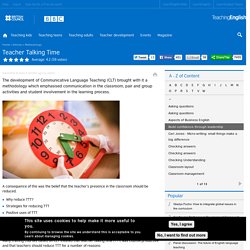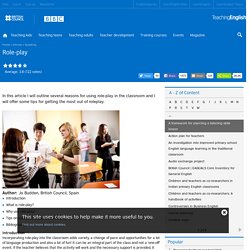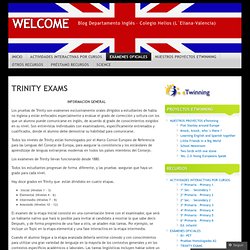Zoom
Trash

Getting students to use more complex functional language. An expanded version of an article of mine just published in English Teaching Professional magazine as Keep Moving On Part One – available here on TEFLtastic for free!

One of the best language learning tips that I have used and passed on is to stop using something as soon as you know how to do so well, and move onto something else. For example, as soon as you can use the equivalent of “In my opinion” or “Can I have…?” In the language that you are studying, you should push yourself to try out “In my honest opinion” or “Is there a… that I can have?” , until you are also comfortable with that new form and so ready to move on again. Getting more complex language from your students Part Two. The follow up to this article, also published in English Teaching Professional.

Given the likelihood that your students often communicate with people who have a lower level of English than they do, there is much to be said for even intermediate-level students getting some practice in simplifying their language in order to accommodate the people they are speaking to. However, even in the “English as a Lingua Franca” world in which we live, I still think our main emphasis should be on persuading our students to move quickly on from language they know well to something more ambitious.
This is especially so when they are in the perfect place to try something new – in our classrooms. Teacher Talking Time. A consequence of this was the belief that the teacher’s presence in the classroom should be reduced.

Why reduce TTT? Strategies for reducing TTT Positive uses of TTT Conclusion Why reduce TTT? Many training courses based on CLT insisted that teacher talking time (TTT) was counterproductive and that teachers should reduce TTT for a number of reasons: Excessive TTT limits the amount of STT (student talking time). Strategies for reducing TTT The over-use of TTT is often the product of the under-use of communicative techniques in the classroom. Other common strategies for reducing TTT include: Using elicitation rather than explanation. Positive uses of TTT In recent years, approaches other than CLT have suggested that TTT may not always be counterproductive and can be used to good effect. Personalised presentations. Conclusion There are advantages and disadvantages to TTT.
Further reading Dellar, H. TBLT Dorathy. Role-play. IntroductionWhat is role-play?

Why use role-play? Tips on successful classroom role-playBibliography IntroductionIncorporating role-play into the classroom adds variety, a change of pace and opportunities for a lot of language production and also a lot of fun! It can be an integral part of the class and not a 'one-off' event. If the teacher believes that the activity will work and the necessary support is provided, it can be very successful. Realistic Lateral Thinking Puzzles. Lateral Thinking Puzzles, unlike most puzzles, are inexact.

In a sense, they are a hybrid between puzzles and storytelling. In each puzzle, some clues to a scenario are given, but the clues don't tell the full story. Your job is to fill in the details and complete the story. Obviously, there is usually more than one answer to any given puzzle, but, in general, only one solution is truly satisfying. You can try solving these puzzles on your own -- that's certainly a legitimate way to go about this -- but usually you can have more fun if you involve other people. Warning: For some reason, these puzzles have a tendency to be rather morbid.
Conversation Questions for the ESL/EFL Classroom. If this is your first time here, then read the Teacher's Guide to Using These PagesIf you can think of a good question for any list, please send it to us. Home | Articles | Lessons | Techniques | Questions | Games | Jokes | Things for Teachers | Links | Activities for ESL Students Would you like to help? If you can think of a good question for any list, please send it to us. If you would like to suggest another topic, please send it and a set of questions to begin the topic.
Trinity training online teacher support. Trinity : Login. Www.funcarele.com/wp-content/uploads/2012/07/Lista-de-precios_derecho-de-matricula_Mayo-2014.pdf. Portada - Bluedoor. Examen Trinity College: Nivel 12. Trinityc.pdf. Gestión Educativa. Trinity College London - Spain - Espa a. Trinity College London - Sesiones de Certificaci n/Acreditaci n - Sesiones SELT. TRINITY EXAMS. Los pruebas de Trinity son exámenes exclusivamente orales dirigidos a estudiantes de habla no inglesa y están enfocados especialmente a evaluar el grado de corrección y soltura con los que un alumno puede comunicarse en inglés, de acuerdo al grado de conocimientos exigidos en su nivel.

Son entrevistas individuales con examinadores, específicamente entrenados y cualificados, donde el alumno debe demostrar su habilidad para comunicarse. Todos los niveles de Trinity están homologados por el Marco Común Europeo de Referencia para las Lenguas del Consejo de Europa, para asegurar la consistencia y los estándares de aprendizaje de lenguas extranjeras modernas en todos los países miembros del Consejo.
Los exámenes de Trinity llevan funcionando desde 1880. Todos los estudiantes progresan de forma diferente, y las pruebas aseguran que haya un grado para cada nivel. Hay doce grados en Trinity que están divididos en cuatro etapas. Blog de Pilar Torres: Nivel B2 Inglés: Acreditaciones válidas. Ante las consultas que me estáis realizando, quiero desde aquí despejar ciertas dudas: El profesorado que imparta áreas no lingüísticas en centros bilingües en Andalucía ha de tener acreditado mínimo un nivel B2 del MCERL.

Barry Tomalin blog 9: teaching the body language. Body language is an important aspect of intercultural communication and using video allows you to observe the body language in action.

I classify body language as follows. * Facial expressions. This includes eye contact, smiling etc. * Gestures: arms folded, arms by the sides, arms waving about etc. * Posture: how people stand, whether they lean forward or sit back, are relaxed or stiff.